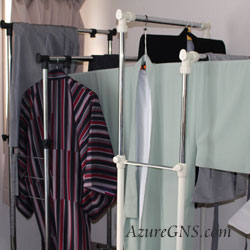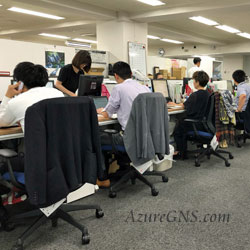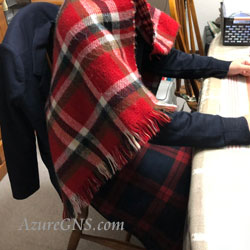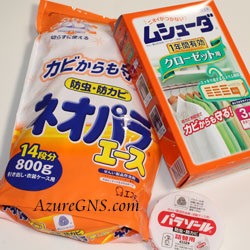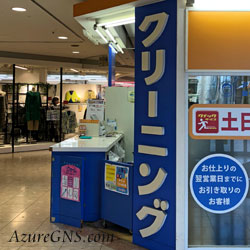(6月と10月)
Koromo-gae;
Seasonal Change of Clothing
(the beginning of June and October)
●衣替え seasonal change of clothing
●衣類 clothes
●制服 uniform
●夏服 summer clothes; summer dress
●冬服 winter clothes; winter dress
●クール・ビズ cool biz; Cool Biz campaign
●ウォーム・ビズ warm biz; Warm Biz campaign
●タンス a chest of drawers
●クローゼット closet
●防虫剤 mothball
●虫に喰われた moth-eaten; eaten by moth
●クリーニング cleaning; dry-cleaning; drt-cleaners
◆日本は四季のある国なので、季節によって気候が変わります。
Japan has four seasons and its climate changes from season to season.
◆それゆえに日本人は季節ごとに衣装を替え、衣装の保存場所も変え、その習慣を衣替えと呼びます。
Therefore, Japanese change clothes and place them into storage each season, and this custom is called Koromo-gae.
◆現代では衣替えと言えば、学校や職場の制服を思い浮かべる人がいます。
Speaking of Koromo-gae, some people are reminded of the uniforms of schools or workplaces.
◆かつては多くの学校、公共施設、銀行、デパートなどでは6月1日と10月1日になると一斉に制服を変えました。
Many schools, public facilities, banks, and department stores used to change their uniforms simultaneously on June 1st and October 1st.
◆しかし、最近は地球温暖化の影響で6月はもうすでに暑く、10月はまだ暑いので衣替えの時期は流動的です。
However, it is already hot in June and continues to remain hot in October due to global warming, so now the timing of Koromo-gae changes every year.
◆環境保護の一環として、環境省はクール・ビズと呼ばれる、ノーネクタイ、ノージャケット、半袖のシャツなどの夏期のビジネス用軽装を提唱するキャンペーンを行っています。
As part of the environmental protection measures, the Ministry of the Environment has carried on a campaign called “Cool Biz”; to wear casual business clothes for summer such as short-sleeved shirts without ties and jackets is advocated.
◆それにより、オフィスでの室内温度を28度と高めに設定することができ、電力消費量を抑えることができ、地球温暖化対策になります。
Therefore, the temperature inside offices can be set at 28 °C (82.4 °F) to reduce electricity consumption for the prevention of global warming.
◆クール・ビズは2005年(平成17年)当時の総理大臣の小泉純一郎氏の提案によるもので、その名前は一般公募によって選ばれ、クール(cool)とビジネスの短縮形ビズ(biz)を組み合わせた造語です。
The Cool Biz campaign was suggested by the then Prime Minister Junichiro Koizumi in 2005 (Heisei 17th yr), and the name derives from the combination of “cool” and “biz” (a shortened form of business) and was chosen by the public.
◆さらに、冬期には「ウォーム・ビズ」と呼ばれるキャンペーンが環境省によって行われており、室内温度を20度の低めに設定して、ジャケットの下にベスト、カーデガン、セーターなどを着たり、分厚い靴下をはいたりすることを奨励しています。
In addition, the “Warm Biz” campaign for winter was also initiated by the Ministry of the Environment in which it is encouraged to wear vests, cardigans or sweaters under jackets and to wear thick socks in slightly cool offices set at 20 °C (68 °F).
◆衣替えの起源は諸説ありますが、平安時代(794-1191)にはすでに行われていたようです。
Though there are various theories on the origin of Koromo-gae, it was already carried out during the Heian period (794-1191).
◆平安時代の宮中では更衣(こうい)と呼ばれ、陰暦の4月1日と10月1日に行われました。
It was called Koi at the court in the Heian period and was done on April 1st and October 1st according to the lunar calendar.
◆江戸時代(1603-1868)の武家はより細かな衣替えの定めに従い、年4回行われました。
Samurai warriors during the Edo period (1603-1868) carried out Koromo-gae four times a year following more detailed manners.
◆現代でも和服に衣替えのしきたりが残ります。
Even now, there are traditional customs of Koromo-gae for Wafuku or Kimono (traditional Japanese national costume).
◆6月から9月まで単衣(ひとえ)、10月から5月まで袷(あわせ)の着物を着るのが正式とされています。
Formally we wear Hitoe (unlined Kimono) from June to September, and Awase (lined Kimono) from October to May.
◆衣替えには湿気の多い雨の日は避け、晴天が続いた日を選びます。
We avoid a moist rainy day and choose a sunny day following a spell of fine weather for Koromo-gae.
◆衣替えの時期は箪笥やクローゼットの中の衣類の整理の時期でもあり、例えば、古い服を処分したり、修理したりします。
We also carefully check clothes in chests and closets in the Koromo-gae season; for example, old clothes are discarded, and others are mended.
◆時期が終わった衣類を洗ったりクリーニングに出したりした後、防虫剤を入れて保存します。
After we wash the clothes at the end of the season or send them to the dry cleaners, we store them with mothballs.
Copyright (C) Azure Global Network Services. All Rights Reserved.
